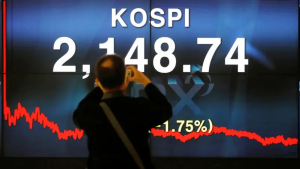Euro zone yields dropped on Thursday, taking cues from moves in U.S. Treasuries after Federal Reserve chair Jerome Powell signalled the central bank could slow its pace of policy tightening as soon as its December meeting.
Powell said the Fed was "slowing down" from the previous pace of three-quarter percentage point rate hikes that has prevailed since June, and would feel the way towards the peak interest rate needed to slow inflation to the Fed's 2% target.
Markets are now pricing in a terminal Fed funds rates of 4.92% at the May meeting next year. Prior to Powell's speech, markets had been pricing in a peak in interest rates at 5.05%, according to data from Refinitiv.
Jefferies interest rate strategist Mohit Kumar said Powell's appearance on Wednesday was dovish compared to his last post-decision press conference.
"The market had built in expectations of a hawkish Powell, and he definitely did not deliver on the hawkish side," Kumar said. Greek October unemployment eases to 11.6%, lowest since 2010 "The dovish element was his view that the terminal rates would be 'somewhat' higher than the September projections, while the market has been viewing terminal rates as substantially higher than the September dot plot of 4.4%," Kumar added.
Germany's 10-year yield, the benchmark for the euro area, dropped 11 basis points (bps) to 1.839%.
The two-year yield, which is more sensitive to changes in interest rate expectations, fell 9 bps to 2.05%.
In Europe, data on Wednesday showed inflation eased by more than expected in November, supporting the case for a slower pace tightening from the European Central Bank (ECB) next month.
ECB chief economist Philip Lane is scheduled to speak on Thursday, which could provide further clues on the central bank's thinking ahead of its meeting on Dec. 15.
"While it is widely accepted that the ECB will have to move into restrictive territory ... the latest inflation data has taken the edge off calls for more larger pre-emptive hiking," ING analysts said in a research note.
Traders have slightly trimmed their bets on a 75 bp hike from the ECB in December, with a 50 bp hike fully priced in and around a 25% chance of a third consecutive 75 bp rate rise, according to Refinitiv data.
Germany's yield curve briefly hit its deepest inversion since 1992. The spread between 2- and 10-year government bond yields fell to -31 bps and was last at -22 bps, Refinitiv data showed.











